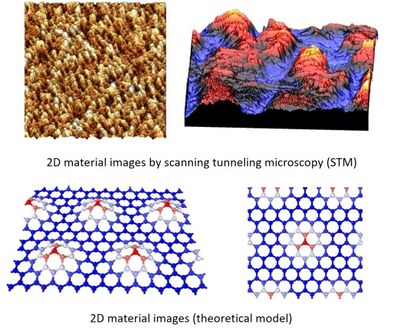A prestigious publication in Nature Nanotechnology for two UNamur researchers
 Graphene, with its single layer of carbon atoms, is the most famous of the 2D materials. His study opened up new fields of research associated with its particular properties, particularly in the field of optics. These include transparent conductors, such as "touch screens". Indeed, graphene is transparent. And it stays that way, no matter what frequency of visible light you use.
Graphene, with its single layer of carbon atoms, is the most famous of the 2D materials. His study opened up new fields of research associated with its particular properties, particularly in the field of optics. These include transparent conductors, such as "touch screens". Indeed, graphene is transparent. And it stays that way, no matter what frequency of visible light you use.
The experimental methods of synthesis usually aim to make the layers as flat as possible. However, researchers at the Institute of Technical Physics and Materials Science (MFA - Budapest, Hungary) have obtained experimental results on the optical responses of rough graphene. "This digital study was perfectly in line with the skills developed by Bruno Majérus during the first part of his thesis as an assistant", explains Professor Luc Henrard, co-author of this article and promoter of Bruno Majérus.
A collaboration through several generations
"Laszlo Biro came to Namur as a guest researcher in the 1990s", continues the researcher. “He then became responsible for the Hungarian laboratory and scientific exchanges took place regularly with the teams of Jean-Pol Vigneron (biophotonics) and Philippe Lambin (2D materials). A Hungarian MFA researcher, Peter Vancso, completed a postdoc at UNamur between 2016-2018 and is now a scientific collaborator at UNamur. It was through him that the team of Levente Tapaszto (the new head of the laboratory) proposed this collaboration. "
The Hungarian research team suggested adapting the optical responses of graphene by amplifying the ripples of the material through heat treatment. The results of the experiments, analyzed by surface enhanced SERS Raman spectroscopy (see definition below) and those of the simulations are promising. Bruno Majérus, also co-author of this article, explains: “The new properties of these materials, linked to roughness, and resulting in a change in properties for visible light could open up interesting avenues in applications of biosensors based on plasmons (excitation of all electrons) such as those already existing for pregnancy tests and Covid-19 rapid tests. Another interesting device is that which allows you to check the glucose level of a diabetic without drawing blood. After placing a subcutaneous device, the result is read using an external blood glucose meter.”
All this is still at the fundamental stage. But as always, it is the experiments and simulations that will one day make it possible to move from theory to practice.
The abstract is available HERE...
More info and more details about the scientific publication? Follow Bruno Majérus on Twitter...
Contact : Luc Henrard - luc.henrard@unamur.be
The UNamur authors
Luc Henrard obtained his doctorate from UNamur in 1996. He carried out postdoctoral research stays at the University of Montpellier then at the National Aeronautical Research Office (ONERA) in Paris. He then returned to UNamur where he held several consecutive mandates as FNRS researcher. He is currently Full Professor in the Department of Physics at UNamur and a member of the NISM Institute. His areas of expertise are solid state physics and the physics of nanosystems, numerical simulations of the electronic and optical properties of solids, 2D materials (including graphene) and plasmonics (study of the optical properties of metallic nanoparticles).
Bruno Majérus obtained his Master degree in physics at UNamur in 2016 under the supervision of Luc Henrard. He is currently a doctoral assistant at the Department of Physics and also a member of the NISM Institute. His research focuses on the theoretical study of the optical properties and plasmons of 2D materials such as graphene.
Definitions
- SERS Raman Spectroscopy: Surface Enhanced Raman Spectroscopy (SERS) is a powerful vibrational spectroscopy technique that enables very sensitive structural detection of samples at low concentration through the amplification of the electromagnetic fields generated by the excitation of plasmons localized at the surface.
- Plasmon: Just as light is made up of photons, the oscillation of free electrons in a material behaves like a plasma and is quantified by plasmons. It is a resonance between light and electrons.











